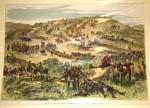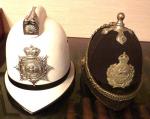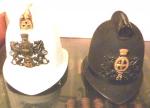-
Posts
13,225 -
Joined
-
Last visited
-
Days Won
22
Content Type
Profiles
Forums
Blogs
Gallery
Events
Store
Everything posted by Mervyn Mitton
-
I always enjoy looking through this section - and as with others comments, am envious of the skills shown. I bought this week, a set of 74 moulded figures - 6.5 mm high. Many of you have possibly seen them since the companies who make these things rely on Worldwide sales and high volumes to make money. Apparantly , you buy a monthly descriptive magazine at your newsagent - and he has the next models in the series, which you also buy. I was told they worked out at about 7 pounds ,$10, each. They are quite heavy and of a composite material. What impressed me was the high quality of the moulding and the detail in the uniforms and , webbing and equipment. I think they were made in Spain and possibly hand painted there or, in Morocco - where labour is cheap. There are large (ish) groups of German, British, French, American and Russian - each one representitive of a particular arm of service. Additionally, there are single figures from other European Countries - Rumania, Turkey etc.. I will show the German group + some close-ups of a few. Should anyone be interested in the others please tell me and I will add them.
-
Well then - perhaps the Queen can open a door ? Interesting your thoughts on the Crown. Queen Victoria's Crown is the King Edward Crown - re-made after the original was lost. The Crown used by Edward, George 5&6 is the Imperial State Crown - created after we declared an Empire in the 1870's. The miniature crown the old Queen wore was also the Imperial. When a new Monarch is proclaimed he/she have several decisions to make. Which Crown - the direction they face on stamps and coins - and the Cypher (initials) they will have used on post boxes, badges etc.. They also, have to decide on the name they will be known as while Sovereign. Some of the wonderful old traditions that persist in Britain.
-
Sal - to my mind these are award numbers and therefore the link is through them. Did you , perhaps, buy them from the same source - even at different times ? Sometimes families sell items and keep back others. The Royal Victorian Order - as I am sure you know, is in the personal gift of the Sovereign and they restrict issue. The Order of Chancery in London (sorry, don't know address, but, I'm sure someone will) will have records and could check these numbers. If they are to the same person - then Bingo ! The alternative is to write to Her Majesty at Buckingham Palace , London. It will of course be dealt with by an assistant - however, with Her interest something is likely to be done - and it impresses the Postman and the neighbours when you get an envelope with the ER Monogram....... Perhaps someone will have other ideas about the numbers ? Mervyn
-
Sal - how would you account for both examples having the 1295 number on their reverses ? The Crown on the Cross is one that I usually associate with late Queen Victoria and early Edward 7th. - the other one is typical George 5 and 6.
-
Graham - I agree with you - it does look like Hussars. There is a medal being worn - but can't quite see the shape of the ribbon. I don't remember the original post - must have a look back. Are you still overseas ? Mervyn p.s. I see he has Musketry - his sabretache has no markings - which is fairly unusual.
-
Jeff - this is Blandford Forum in Dorset. Their leading family are the Bastards - always a source of schoolboy humour ! (Actually, it is pronounced BAAST-ARD ). Many of the smaller towns had Volunteer Brigades who served when required. This could well be one - and would account for the date bars. A lot of them still exist and do great service. To find out more , I suggest you write to the : Town Clerk, Blandford Forum, Dorset. UK. I think they have a good museum and ask him to forward your letter. I'm sure they will still have the records.
-

Camberwell police
Mervyn Mitton replied to Tony's topic in Great Britain: Mervyn Mitton's British & Colonial Police Forces
Well - that seems to pin it down. We tend to forget the changes in ranks and divisions so, good that you established them. The actual ceremony may have been for more than one person. There are two clocks on the table - and it looks like some smaller items. -
Finally, for this posting - another warrior's arm or, ankle band. These are made from brass and are very heavy. Usually they were fitted when red hot and were kept on at all times. How did they put them on when red hot ? The arm - or, leg - was covered with wet hides. I have shown these before , but they are now rare items.
-
This small knobkerrie - or, Iwisa, was issued to African constables of the Durban Police in about 1900. It is about two feet long (60cm). In those days every European police officer was supported by two black constables. They dealt with African prisoners - in most cases - and were not allowed to have contact with Europeans. This is a rare item.
-
When Chelmsford first started his attack on Zululand, he made the mistake of splitting his Forces into three columns. The column under Sir Evelyn Wood VC acquitted itself well and won the battle of Kambula. We all know what happened to the second column at Isandlawana, when they were so badly defeated by the Zulu Impis. The third column under Colonel Pearson was sent across the Tugela River and was to march on the King's capital at Ulundi from the South East. They reached as far as a small settlement at Eshowe (called Ekowe in those days) and suddenly found themselves besieged by 20,000 warriors. This went on for four months - and was possibly the reason we did not suffer a greater defeat, since 1/4 of available warriors were involved in the siege. When Chelmsford had things under control, he sent a large relieving force - and this original 1879 print from the Illustrated London News shows them on the March. A drift was a cutting where in the rains a stream had washed a deep gully. With ox waggons drawn by teams of 8 they were formidable to cross and a lot of manpower was required. We had teams of african labourers who cut logs and helped fill them-in. Some can be seen on the left. All of our African auxiliaries wore a red bandana around their head - or, on their arm - to prevent confusion in attacks. Central in the picture is a senior officer, accompanied by his local guides. You will note that in addition to the massed ranks of our infantry, each waggon also has a detachment - the contents of the waggons were valuable. There is a cavalry detachment on the left and the warriors on the right are carrying the Ishilungu - , or main battle shield. This was made from bull's hide and was very heavy. Eshowe later became the HQ for the Nonquai - or, local Zulu Police and there still remains the original fort built-in 1881.
-
Despite my misgivings when I first started this thread, it would seem that we have a small following. Perhaps this is because everyone has heard of the Zulu Warriors and their exploits - but, information is actually quite hard to come-by. I have a few items that have built-up and will add them now. This first is a chart showing the succession of the Zulu Kings from Shaka to the present King Goodwill Zwelathini. The name Zulu is in fact a Clan name and when Shaka took over it is thought that there were as few as 2500 people entitled to the name. With his conquests and subjugation of surrounding Clans, he made them take the name Zulu - and so the Nation was borne. The word King is a European concept - prior to the early settlers calling him this, the local word meant a Chief of Chiefs - , as we always called them - Paramount Chiefs. The population grew to around 250,000 to 300,000 by the 1879 Anglo-Zulu War. In the 1950's it had risen to about 3,500,000 - and today, the last census stood at over 12 million. Because of the size of the area and the inaccesability - they take photos on a grid basis and count by hand.
-

Camberwell police
Mervyn Mitton replied to Tony's topic in Great Britain: Mervyn Mitton's British & Colonial Police Forces
Yes - with this magnification you can see whistle chains. Thank goodness for that - I was getting worried - rattles had gone out in the 1860's. I think the man in the front in a cap and holding a stick, must be the band master ? -

Gordon F.S. helmet hackle
Mervyn Mitton replied to jf42's topic in Great Britain: Militaria: Badges, Uniforms & Equipment
jf - my apologies for breaking into your thread - however, such gratuitous insults to our Forum required an answer. A simple enquiry from him would have cleared the matter. Unfortunately, I felt it necessary to draw Nick's attention and he obviously felt the same ! I have heard stories about incidents of routine insults amongst members of other forums, that I find hard to believe - all the more reason that we keep GMIC on a responsible and friendly path. The incident is now finished and I hope members will continue to respond to this historically interesting thread. Mervyn -

ANOTHER BI-CORNE HAT
Mervyn Mitton replied to Mervyn Mitton's topic in Great Britain: Militaria: Badges, Uniforms & Equipment
Stuart - only the white feathers. Although he has a very senior rank - being the Queen's Deputy in his appointed County - it is a civilian rank. They also carry a designated sword. -
Most of the earlier medals had examples that were pin mounted or, brooch mounted. The practise did really start with the Crimea War since medals were in greater numbers. However, I see lots of examples from the Zulu War and the Boer War. Occasionally - if the man was killed, the widow will wear the Medal in Memoriam - the more common practise was that the man would have it either mounted with the pin and catch - or, a full silver mount with the pin on the edges of the mount - this he would then give to his wife or, sweetheart. The pin mounts do a lot of damage - the brooch mount is better - but still requires a suspender and any clasps to be re-attached. I suppose the medal is de-valued by about 40 %.
-
Peter - this was the standard size and shape for Constabulary swords - from the 1750's to about the 1870's. The sword it was originally based on was a civilian sword called the 'Hounslow Hangar'. Being fairly short it could be easily drawn and had a downward swing - Hounslow was a large and very rough are a of parkland in London. The shape is so typical of the Police swords that it is why I said - apart from the grip - it is to all intents and purposes - Police. But not with this handle....
-

Camberwell police
Mervyn Mitton replied to Tony's topic in Great Britain: Mervyn Mitton's British & Colonial Police Forces
Craig - now that was a surprise that I actually remembered the Div. Station after so many years........ Thanks for the confirmation. Tony - this is how the whistle was worn. This was the Met's No.1 Uniform - worn until - I think - 1972, and it the same uniform as in your picture. ( Yes - it's me - on the way to 'Trooping the Colour.) -

Gordon F.S. helmet hackle
Mervyn Mitton replied to jf42's topic in Great Britain: Militaria: Badges, Uniforms & Equipment
Toby and DrPhil - I was not aware that there was an image restriction for new members - it has always been 10 posts before you get a reasonable size picture for posting. I think your comments are rather unfair - the Forum welcomes new members and does everything to support them - however, can you really say the same Toby, when you have posted in such a small way since you joined ? Perhaps if you can get up to the 10 number it will be easier ? I will ask our Chairman about your points - however, I would like to say something in defence of the restrictions. New members often join - take advantage of the free joining to post a question - or, to sell something - and then disappear. Paying a small subscription shows your integrity and immediately gives you priviledges you would have to work up to as a free member. Join-in - you will soon find friends and we will welcome your knowledge input. Mervyn Mitton -

Lango Police
Mervyn Mitton replied to Adrob's topic in Great Britain: Mervyn Mitton's British & Colonial Police Forces
I'm not sure who the Lango Police are ? Were they part of Portuguese Africa ? ******Sometimes I surprise myself. Checked Google and it's some small Province in Uganda - near the Sudan border. This means it will be the standard British Colonial pattern uniform - blue/grey shirt and shorts. Blue peaked cap. Maybe someone will have an example in their collection ?












